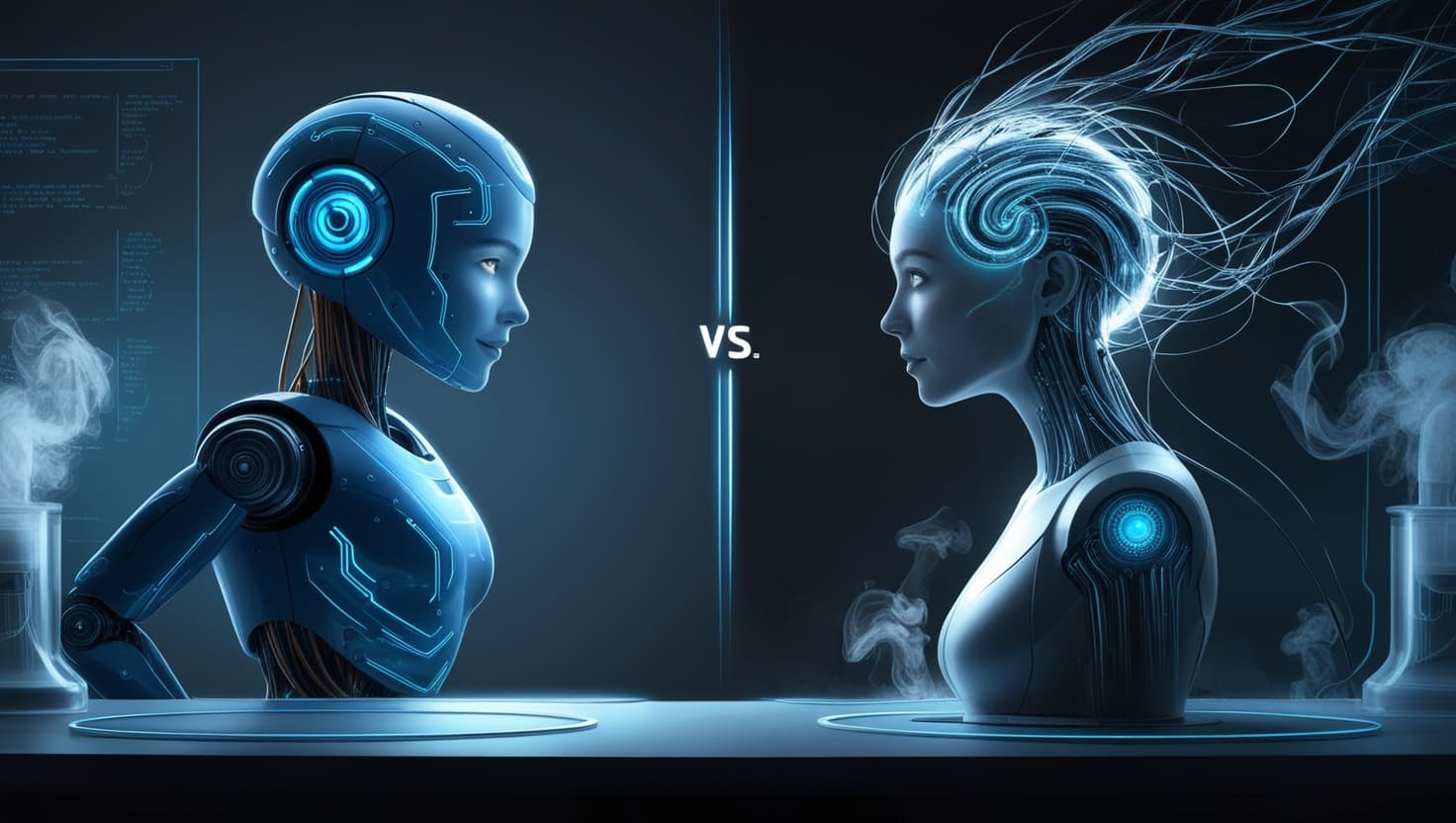
Understanding the Differences & Choosing the Right Approach
Artificial Intelligence continues to evolve rapidly, introducing new paradigms that redefine how we design intelligent systems. Two concepts that often cause confusion—but are crucial to distinguish—are AI Agents and Agentic AI. While both involve autonomous behavior, their design philosophies, capabilities, and use cases differ significantly.
In this blog, we’ll define each term, explore real-world examples and applications, compare the two, and help you decide when to use each.
What is an AI Agent?
An AI agent is a system that perceives its environment and takes actions to achieve a specific goal. AI agents operate based on predefined logic, rules, or learning models, and they often handle a narrow set of tasks within a fixed context. An AI agent is a computational system designed to autonomously perceive its environment, process information, and act to achieve specific objectives. AI agents form the foundational layer of many modern intelligent systems and are built to solve well-defined problems with a consistent and efficient approach. Understanding the key characteristics of AI agents is essential to recognize their capabilities and limitations.
Goal-Oriented:
At its core, an AI agent is goal-oriented, meaning it is programmed or trained to pursue a particular objective. This goal can be as simple as navigating to a location or as complex as optimizing a logistics route. The agent continuously evaluates its environment and determines which actions will bring it closer to its goal. Whether using rule-based logic or machine learning, the agent's behavior is consistently aligned with this intended outcome. A navigation bot in a warehouse is designed to move items from point A to point B. It constantly evaluates its path and surroundings to ensure it meets this goal efficiently.
Reactive or Proactive:
AI agents can be reactive, proactive, or a combination of both. Reactive agents respond directly to stimuli from their environment. Their decision-making is based on the current state without anticipation or planning. These are suitable for real-time systems that require quick responses. Proactive agents, on the other hand, initiate actions on their own to fulfill their objectives, sometimes anticipating future states or events. They may use predictive models or schedules to act even without an immediate external trigger. A smart thermostat that adjusts temperature only when it detects a change in room conditions is reactive. One that lowers the temperature preemptively based on learned user behavior is proactive.
Environment Based:
AI agents operate within a defined environment—either physical (like robots in a warehouse) or digital (like Chabot on a website). The characteristics of the environment, such as its complexity, predictability, and available data, directly influence the design of the agent. Agents typically assume a static or semi-dynamic environment, where boundaries and rules are clearly specified. In general, the more constrained and structured the environment, the more effective traditional AI agents tend to be. As an example, an AI agent managing stock trades functions within the well-defined rules of the financial market, while a vacuum robot operates in a structured spatial map of a house.
Stateless with Limited Memory:
A notable characteristic of most traditional AI agents is that they are stateless or possess only limited memory. Stateless agents do not retain any information between interactions; they make decisions based solely on the current input. In contrast, agents with limited memory may remember a short history or maintain a small context window, allowing slightly more sophisticated decision-making without long-term tracking. This design keeps agents lightweight and efficient, but limits their ability to handle tasks that require deep context, learning over time, or adaptive strategies. A rule-based Chabot that answers queries without tracking previous conversations is stateless. A customer support bot that remembers user preferences during a session is using limited memory.
Examples of AI Agents:
- Chabot: Answer customer support questions based on intent recognition.
- Recommendation Engines: Suggest products or content based on past user behavior.
- Game AI: Bots that make decisions in strategy games based on state evaluation.
- RPA bots: Automate repetitive business tasks such as data entry or invoice matching.
Summary
An AI agent is a focused, task-driven entity built to act within a defined scope and environment. With characteristics such as goal orientation, reactive/proactive behaviors, constrained operating contexts, and minimal memory, AI agents are best suited for simple to moderately complex tasks that require consistent, repeatable outcomes. Their reliability, speed, and clarity of function make them essential components in many enterprise, consumer, and industrial applications. However, for more dynamic, context-rich scenarios, agentic AI may be a more suitable approach.
What is Agentic AI?
Agentic AI, on the other hand, refers to AI systems with a higher level of autonomy, reasoning, and long-term planning. These systems are not just reactive—they can break down tasks, make intermediate decisions, handle uncertainty, and adapt strategies over time to accomplish complex goals. Agentic AI typically leverages large language models (LLMs) or multi-agent collaboration frameworks. Agentic AI represents a significant evolution beyond traditional AI agents, introducing systems that exhibit high levels of autonomy, reasoning, adaptability, and long-term contextual awareness. These systems are designed not only to perform tasks but to understand, plan, and manage complex processes in dynamic environments.
Autonomous Planning:
One of the most distinguishing features of Agentic AI is its ability to autonomously plan and execute multi-step tasks. Unlike traditional AI agents that act on predefined logic or single-step instructions, Agentic AI can break down high-level goals into a series of actionable steps, determine the optimal sequence, and execute them with minimal or no human intervention.
These systems often rely on reasoning capabilities, goal decomposition, and planning frameworks. They may also use large language models (LLMs) or specialized task orchestration engines to adapt their plans as new data emerges.
A personal AI assistant tasked with “plan a business trip to New York” can independently book flights, reserve hotels, coordinate with the calendar, and even generate an expense report—all without requiring the user to spell out each individual task.
Reflective Intelligence:
Agentic AI systems possess a level of reflective intelligence, enabling them to evaluate their own progress, adjust strategies, and learn from failures. This meta-cognitive ability allows them to recognize when a plan is not working and pivot toward a new approach, enhancing resilience and adaptability in real-world scenarios.
Self-evaluation may include:
- Checking task completion accuracy
- Measuring outcomes against expected results
- Re-assessing goals based on changing context
An AI research assistant running a literature review can detect that a set of articles does not answer a given hypothesis, reassess its search strategy, and refine the query to yield better results.
Collaboration:
Agentic AI can collaborate with other agents, tools, APIs, or humans, forming complex systems of coordinated activity. These agents can delegate tasks, request information, or integrate the output of other agents to accomplish broader objectives.
This collaboration enables distributed intelligence, where multiple specialized agents work in tandem—each with distinct roles but working toward a shared goal. It mirrors human organizational behavior and can lead to highly scalable and modular AI systems.
An AI project manager agent might collaborate with a calendar agent, a document-writing agent, and a budgeting agent to autonomously prepare a project proposal end-to-end.
Memory and Contextual Awareness:
Agentic AI typically incorporates persistent memory or long-term context tracking, allowing it to remember prior interactions, user preferences, completed tasks, and contextual history. This enables personalized and coherent long-term behavior, especially in applications that require continuity and learning over time.
This memory can be stored in:
- Session-based memory (short-term)
- External memory systems (long-term)
- Embedded within knowledge graphs or vector stores
An AI project manager agent might collaborate with a calendar agent, a document-writing agent, and a budgeting agent to autonomously prepare a project proposal end-to-end.
Summary
An AI agent is a focused, task-driven entity built to act within a defined scope and environment. With characteristics such as goal orientation, reactive/proactive behaviors, constrained operating contexts, and minimal memory, AI agents are best suited for simple to moderately complex tasks that require consistent, repeatable outcomes. Their reliability, speed, and clarity of function make them essential components in many enterprise, consumer, and industrial applications. However, for more dynamic, context-rich scenarios, agentic AI may be a more suitable approach.
By contrast with traditional AI agents—which are typically narrow, reactive, and stateless—Agentic AI offers a more powerful, flexible, and human-like approach to intelligent system design, opening the door to true autonomy in digital systems.
AI Agents vs. Agentic AI: Side-by-Side Comparison
| Feature | AI Agent | Agentic AI |
|---|---|---|
| Autonomy Level | Task-level automation | Goal-level autonomy |
| Planning Capability | Minimal or rule-based | Multi-step, dynamic planning |
| Self-Evaluation | Typically none | Reflective, capable of adjusting actions |
| Context Awareness | Stateless or short-term memory | Long-term memory and contextual understanding |
| Tool Use & Collaboration | Single-purpose, isolated | Multi-agent collaboration and external tool integration |
| Adaptability | Low – fixed behavior | High – adapts to changing goals and environments |
| Complexity | Low to moderate | High |
| Example Task | “Send a reminder email” | “Manage my schedule, prioritize meetings, and summarize notes” |
When to Use Each: Practical Guidelines
Use AI Agents when:
- The task is simple, well-defined, and repetitive
- Speed and reliability are more important than adaptability
- The environment is stable and constrained
- You need low-cost, low-complexity solutions
Examples: Automating customer service chats, processing invoices, routing support tickets, generating standard reports.
Use Agentic AI when:
- The task is complex or open-ended
- It requires multi-step planning and dynamic decision-making
- You need personalized or contextual interaction over time
- The environment is dynamic or involves interacting with multiple systems
Examples: Building autonomous research tools, digital personal assistants, enterprise workflow orchestrators, or decision-support systems.
Conclusion
The distinction between AI agents and Agentic AI lies in depth of autonomy, intelligence, and adaptability. AI agents serve well for focused, repetitive tasks within a known environment. Agentic AI, in contrast, represents the next generation—autonomous, reasoning-driven systems capable of navigating complexity and ambiguity.
Choosing between the two depends on your goals, environment, and the complexity of the tasks you aim to automate. As Agentic AI continues to mature, it will increasingly become the backbone of next-gen enterprise automation, research, and personalized digital assistance.
